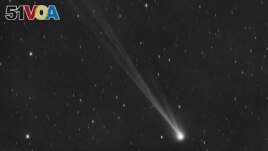A newly discovered comet is passing through our solar system for the first time in more than 400 years.
Scientists say star watchers across the Northern Hemisphere should look to the sky as soon as possible, either this week or early next. They say it will be another 400 years before the comet returns to our neighborhood.
The comet's official name is C/2023 P1 Nishimura. It is about one kilometer wide. Comet Nishimura will travel to within 125 million kilometers of the Earth on September 12.

This image provided by Gianluca Masi shows the comet C/2023 P1 Nishimura and its tail seen from Manciano, Italy on Sept. 5, 2023. (Gianluca Masi via AP)
The comet was discovered in August by a Japanese star watcher, Hideo Nishimura. He discovered the comet using 30-second-long exposures with a digital camera.
The American space agency NASA says the comet has increased in brightness as it crosses our solar system. As the comet heads closer to the Sun, it will continue to get brighter.
Early risers should look toward the northeastern horizon about 90 minutes before sunrise. The comet will be less than 10 degrees above the horizon making it difficult to see.
Paul Chodas is head of NASA's Center for Near-Earth Object Studies. He said, "You really need a good pair of binoculars to pick it out and you also need to know where to look."
The comet will come closest to the sun on about September 17. Then it will leave the solar system. Chodas said that the comet is "likely to survive its passage," meaning he does not believe it will burn up near the sun.
Italian astronomer Gianluca Masi is the founder of the Virtual Telescope Project. He said in an email to the Associated Press that the next week represents "the last, feasible chances" to see the comet from the Northern Hemisphere before it is lost in the sun's glare.
"The comet looks amazing right now, with a long, highly structured tail, a joy to image with a telescope," he said.
If it survives its passage by the sun, the comet should be visible in the Southern Hemisphere by the end of September, Masi said.
Professional astronomers use powerful telescopes around the world to watch the sky. It is unusual for a non-professional sky watcher to discover a comet these days. Chodas of NASA said of Nishimura's discovery, "This is his third find, so good for him."
The comet last visited about 430 years ago, Chodas said.
I'm Mario Ritter, Jr.
Marcia Dunn reported this story for the Associated Press. Hai Do adapted this report for VOA Learning English with additional material from NASA.
____________________________________________________
Words in This Story
exposure –n. the amount of time a camera takes to capture an image
horizon –n. the line in the distance where the Earth and the sky appear to meet
degrees –n. (pl.) a unit for measuring the size of an angle which is also used to talk about apparent position in the sky
binoculars –n (pl.) a kind of hand-held telescope that can be placed in front of both eyes to make things that are far away appear closer
feasible –adj. able to be done
glare –n. light that is so bright it is hard to look at
